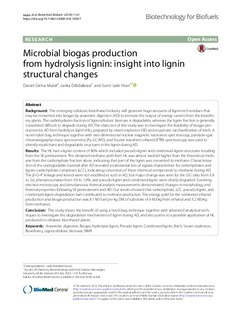| dc.contributor.author | Mulat, Daniel Girma | |
| dc.contributor.author | Dibdiakova, Janka | |
| dc.contributor.author | Horn, Svein Jarle | |
| dc.date.accessioned | 2018-08-16T10:32:53Z | |
| dc.date.available | 2018-08-16T10:32:53Z | |
| dc.date.created | 2018-07-09T15:32:45Z | |
| dc.date.issued | 2018 | |
| dc.identifier.citation | Mulat, D. G., Dibdiakova, J., & Horn, S. J. (2018). Microbial biogas production from hydrolysis lignin: insight into lignin structural changes. Biotechnology for biofuels, 11(1), 61. | nb_NO |
| dc.identifier.issn | 1754-6834 | |
| dc.identifier.uri | http://hdl.handle.net/11250/2558243 | |
| dc.description.abstract | Background: The emerging cellulosic bioethanol industry will generate huge amounts of lignin-rich residues that may be converted into biogas by anaerobic digestion (AD) to increase the output of energy carriers from the biorefnery plants. The carbohydrates fraction of lignocellulosic biomass is degradable, whereas the lignin fraction is generally considered difcult to degrade during AD. The objective of this study was to investigate the feasibility of biogas production by AD from hydrolysis lignin (HL), prepared by steam explosion (SE) and enzymatic saccharifcation of birch. A novel nylon bag technique together with two-dimensional nuclear magnetic resonance spectroscopy, pyrolysis–gas chromatography–mass spectrometry (Py-GC/MS), and Fourier transform infrared (FTIR) spectroscopy was used to identify recalcitrant and degradable structures in the lignin during AD. Results: The HL had a lignin content of 80% which included pseudo-lignin and condensed-lignin structures resulting from the SE pretreatment. The obtained methane yield from HL was almost twofold higher than the theoretical methane from the carbohydrate fraction alone, indicating that part of the lignin was converted to methane. Characterization of the undegradable material after AD revealed a substantial loss of signals characteristic for carbohydrates and lignin–carbohydrate complexes (LCC), indicating conversion of these chemical components to methane during AD. The β-O-4′ linkage and resinol were not modifed as such in AD, but major change was seen for the S/G ratio from 5.8 to 2.6, phenylcoumaran from 4.9 to 1.0%, and pseudo-lignin and condensed-lignin were clearly degraded. Scanning electron microscopy and simultaneous thermal analysis measurements demonstrated changes in morphology and thermal properties following SE pretreatment and AD. Our results showed that carbohydrate, LCC, pseudo-lignin, and condensed-lignin degradation had contributed to methane production. The energy yield for the combined ethanol production and biogas production was 8.1 MJ fuel per kg DM of substrate (4.9 MJ/kg from ethanol and 3.2 MJ/kg from methane). Conclusion: This study shows the beneft of using a novel bag technique together with advanced analytical techniques to investigate the degradation mechanisms of lignin during AD, and also points to a possible application of HL produced in cellulosic bioethanol plants. | nb_NO |
| dc.language.iso | eng | nb_NO |
| dc.rights | Navngivelse 4.0 Internasjonal | * |
| dc.rights.uri | http://creativecommons.org/licenses/by/4.0/deed.no | * |
| dc.title | Microbial biogas production from hydrolysis lignin: Insight into lignin structural changes | nb_NO |
| dc.type | Journal article | nb_NO |
| dc.type | Peer reviewed | nb_NO |
| dc.description.version | publishedVersion | nb_NO |
| dc.rights.holder | This article is distributed under the terms of the Creative Commons Attribution 4.0 International License (http://creativecommons.org/licenses/by/4.0/), which permits unrestricted use, distribution, and reproduction in any medium, provided you give appropriate credit to the original author(s) and the source, provide a link to the Creative Commons license, and indicate if changes were made. The Creative Commons Public Domain Dedication waiver (http://creativecommons.org/publicdomain/zero/1.0/) applies to the data made available in this article, unless otherwise stated. | nb_NO |
| dc.source.volume | 11 | nb_NO |
| dc.source.journal | Biotechnology for Biofuels | nb_NO |
| dc.source.issue | 61 | nb_NO |
| dc.identifier.doi | 10.1186/s13068-018-1054-7 | |
| dc.identifier.cristin | 1596417 | |
| dc.relation.project | Norges forskningsråd: 243950 | nb_NO |
| cristin.ispublished | true | |
| cristin.fulltext | original | |
| cristin.qualitycode | 1 | |

